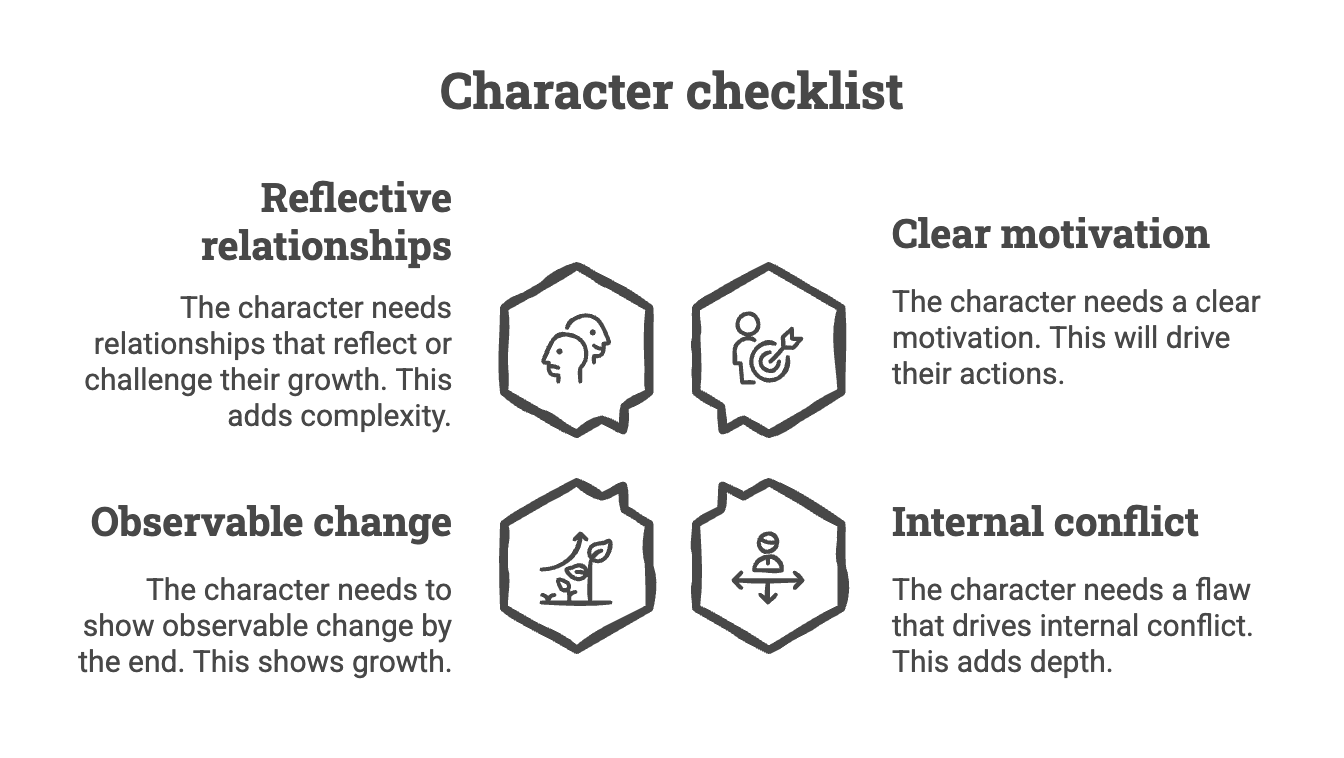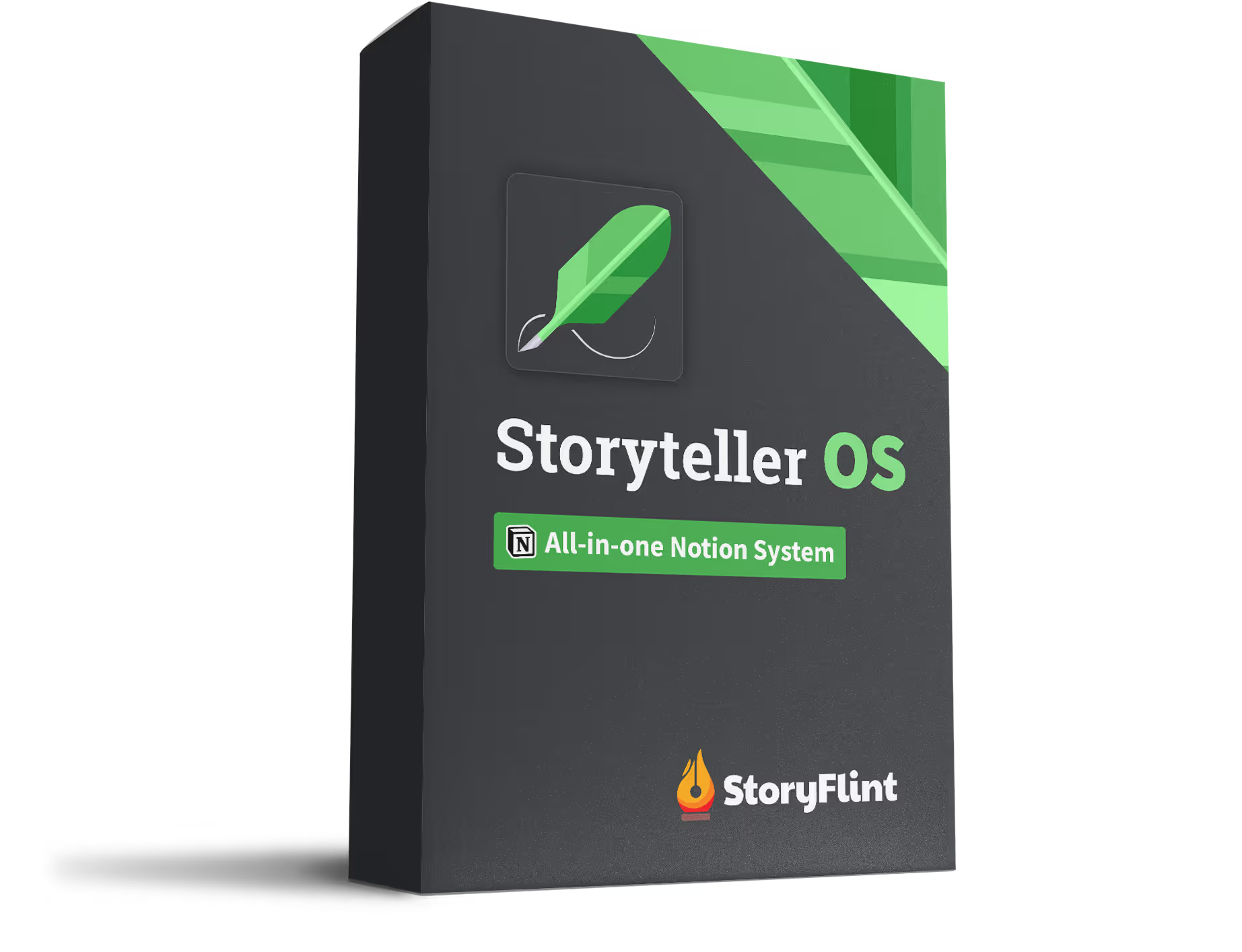[.tldr-section]TL;DR: Every story—no matter the genre, style, or medium—is built from eight core elements: character, setting, plot, conflict, theme, tone, point of view, and style. These elements work together to engage your audience, create emotional investment, and give your story structure and meaning.[.tldr-section]
If your story ever feels flat or directionless, one of these elements is probably weak or missing. Strengthen them, and your story will start to come alive.
1. Character: The Beating Heart of Your Story
Stories live and die by their characters. A compelling protagonist with a clear goal gives your audience someone to root for—or against.
Ask yourself:
- What does my main character want more than anything (their goal)—and why can’t they have it yet (their obstacle)?
- What’s their flaw or misconception (K.M. Weiland’s “Lie the Character Believes”)?
- How do they change by the end (their arc)?
Example: Katniss Everdeen in The Hunger Games begins by surviving for her family. By the end, she fights for something bigger—freedom and compassion in a brutal world.
Quick Checklist:
✅ Clear motivation
✅ Flaw that drives internal conflict
✅ Observable change by the end
✅ Relationships that reflect or challenge their growth

Read this article on developing a character.
2. Setting: The World That Shapes the Story
The setting isn’t just background—it’s pressure. It shapes who characters become and what they believe.
A strong setting:
- Reflects your story’s theme (e.g., a crumbling empire mirrors moral decay)
- Creates constraints that generate conflict
- Feels lived in, with sensory details that anchor readers in place
Examples:
- The Shire in The Lord of the Rings represents peace and innocence worth fighting for.
- Gotham City mirrors Batman’s internal darkness and moral ambiguity.
Pro Tip:
Map your setting’s rules—physical, cultural, and emotional—and show how breaking them creates story movement.
3. Plot: The Spine That Holds Everything Together
Plot gives your story momentum. It’s the structured sequence of cause-and-effect events that pull your audience forward.
Think of John Truby’s framework: desire → conflict → revelation → change.
The classic structure:
- Setup – establish your world and character goals
- Inciting Incident – something changes their normal world
- Rising Action – challenges and obstacles increase tension
- Climax – the hardest choice that defines who the character truly is
- Resolution – the new normal, transformed by that choice

4. Conflict: The Engine of Emotion
No conflict, no story. Conflict is what turns your character’s desire into a struggle worth watching.
There are three major types:
- Internal Conflict: Character vs. self (moral or emotional struggle)
- External Conflict: Character vs. world or antagonist
- Interpersonal Conflict: Character vs. another’s goals or values
Examples:
- Breaking Bad’s Walter White battles his ego as much as his enemies.
- Pride and Prejudice pits Elizabeth Bennet’s pride against Darcy’s prejudice—simple but universal tension.
Quick Tip:
Each scene should include at least one form of conflict—emotional, relational, or situational. Otherwise, it’s filler.
5. Theme: The Moral Argument Beneath It All
Theme is the “why” behind your story. It’s your view of how people should act in the world.
John Truby calls it the moral argument—your story’s backbone. It’s not about preaching; it’s about showing how actions lead to consequences.
Ask yourself:
- What belief is my character forced to confront?
- What truth do they (and the audience) walk away with?
Examples:
- Inside Out: Emotional pain is not the enemy—it’s part of growth.
- The Godfather: Power without morality leads to ruin.
6. Tone: The Emotional Flavor
Tone is your story’s emotional temperature—the feeling that lingers after every line. It’s what makes a horror story chilling or a rom-com cozy.
Tone depends on your word choice, pacing, and imagery.
A story about loss can feel tragic (The Fault in Our Stars) or absurdly funny (The Good Place) depending on tone.
Pro Tip:
Align your tone with your story’s theme and audience. If your tone fights your theme, the story feels off-key.
7. Point of View (POV): The Lens That Frames the Truth
POV shapes how your audience experiences the story’s world—and whose truth they believe.
Common POV types:
- First Person: Immediate and emotional (The Catcher in the Rye)
- Third Person Limited: Balanced insight (Harry Potter)
- Third Person Omniscient: Broad scope (Pride and Prejudice)
- Second Person: Rare but intimate (Bright Lights, Big City)
Tip:
Don’t just pick a POV—use it strategically. What your narrator hides or misinterprets adds mystery and depth.
8. Style: The Voice Behind the Words
Style is your fingerprint. It’s how your word choice, rhythm, and structure create your story’s personality.
It’s shaped by:
- Sentence length and rhythm
- Word choice (formal vs. casual, poetic vs. blunt)
- Dialogue style and subtext
- Symbolism and motif
Example: The minimalist prose of Hemingway vs. the lyrical density of Toni Morrison—two styles that couldn’t tell the same story.
Try this exercise: Rewrite one paragraph of your story in three styles: minimal, poetic, and humorous. See how it changes tone, pacing, and meaning.
How the 8 Elements Work Together
A good story isn’t eight separate parts—it’s an ecosystem. Change one element, and the others react.
Example: In The Silence of the Lambs, Clarice’s character arc (internal conflict) drives the plot, her moral choices define the theme, and the cold, clinical tone builds suspense. Every element feeds the others.
When all eight align, your story moves with emotional logic and purpose.
How the Storyteller OS Brings It All Together
Building and connecting these eight elements can get messy fast—especially when you’re juggling multiple story ideas, timelines, and character arcs. That’s why the Storyteller OS was built.
It’s an all-in-one Notion system designed to help you:
- Build every story element in one place. Characters, worlds, plots, and themes all live in connected documents that talk to each other.
- Visualize relationships. See how a character’s arc affects plot beats or how a setting reflects your theme through linked views and dashboards.
- Stay consistent. No more forgetting eye colors, missing side characters, or losing your plot threads across documents.
- Plan and write in flow. From brainstorming to drafting, everything’s designed to reduce friction and keep you focused on writing, not organizing.
If your story ideas are scattered across sticky notes and Google Docs, Storyteller OS gives them a home—and a structure that helps you actually finish your draft.
👉 Start your story today with Storyteller OS.
Story Element Self-Audit Checklist
Use this mini-audit to strengthen your draft:
- Character: Does my protagonist want something specific and difficult to get?
- Setting: Does my world reflect or challenge my theme?
- Plot: Does every event cause the next one logically?
- Conflict: Is tension present in every major scene?
- Theme: Can I summarize my story’s message in one sentence?
- Tone: Is the emotional mood consistent and intentional?
- POV: Am I revealing the right amount of information at the right time?
- Style: Do my sentences sound like me, or like everyone else?
FAQs About Story Elements
What are the 8 elements of a story?
Character, setting, plot, conflict, theme, tone, point of view, and style. Some frameworks also include structure or symbolism as additional elements.
Why are story elements important?
They give your story shape, coherence, and emotional depth. Without them, your narrative feels random or hollow.
Can you have a story without all eight elements?
Technically yes—but it probably won’t resonate. The strongest stories integrate all of them in balance.
Are there differences between story elements and narrative elements?
Slightly. Narrative elements often refer to how a story is told (structure, pacing, perspective), while story elements refer to what it’s about (plot, character, theme).
What’s the best way to develop story elements?
Plan intentionally. Revisit each element during outlining and revision. Tools like StoryFlint’s Storyteller OS can help you track, connect, and refine them in one place.
Final Thoughts
Every story, from a Marvel blockbuster to your first short story draft, lives on these same eight pillars. You don’t have to master them all at once—just strengthen one at a time.
Start with what’s weakest. Refine it. Then watch how every other part of your story starts to click into place.





